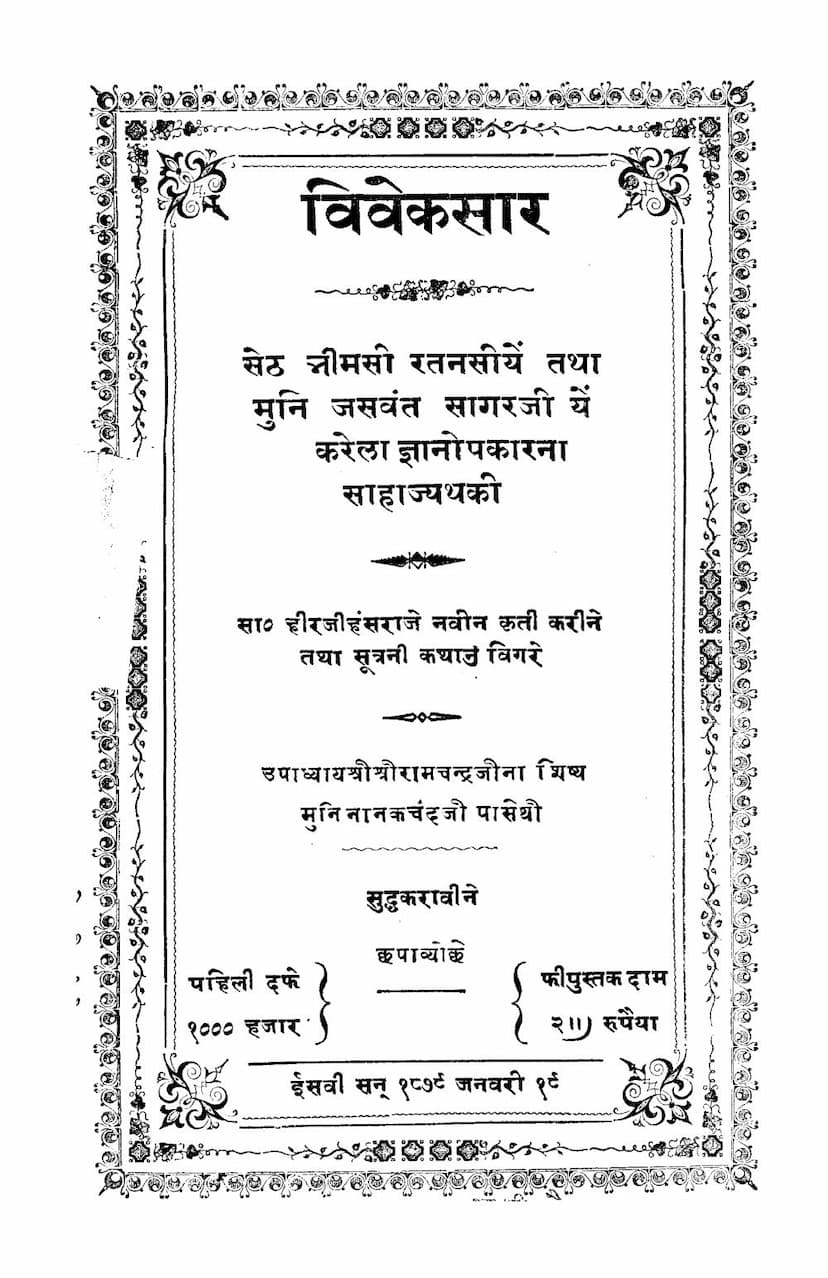Viveksar
Added to library: September 2, 2025

Summary
This summary is based on the provided text, which appears to be a scanned copy of a Jain religious book titled "Viveksar" by Shravak Hiralal Hansraj, published in 1878. The text is primarily in Gujarati, with some Sanskrit phrases.
Here's a breakdown of the content:
1. Title and Author:
- Title: Viveksar (विवेकसार)
- Author: Shravak Hiralal Hansraj (सा० हीरजीहंसराजे)
- Publisher: Shravak Hiralal Hansraj
- Publication Year: 1878 (ईसवी सन् १८७८)
- Catalog Link: https://jainqq.org/explore/020913/1
2. Introduction and Purpose: The book appears to be a compilation of various Jain religious works, poems, stories, and philosophical discussions. The author, Hiralal Hansraj, mentions that the book was printed in 1878 and revised or compiled from the teachings of Upadhyay Jiramchandji's disciple, Muni Nanakchandji.
The preface expresses a concern about the proliferation of different Jain sects (Gachhas and Panths) and the associated disagreements and animosity between them. The author aims to promote understanding and discourage such division among Jain followers.
3. Contents (Table of Contents - Page 4): The table of contents reveals a diverse collection of Jain literature:
- Praise for Lord Vardhaman (Shri Vardhaman Saneso)
- Poems/Songs (Stavan, Chowvisi, Band, Lavani)
- Stories from Jain scriptures (Uttarayana Katha, Karmavipaka Katha, Pratyekbuddha Katha)
- Philosophical treatises (Tatva Vivek, Samyaktotpatti)
4. Key Themes and Discussions:
- Discrimination between Jain Sects: A significant portion of the text (pages 5-13) addresses the differences and conflicts between various Jain sects, particularly between Shvetambaras and Digambaras. The author discusses issues like the veneration of Jinabimba (idols), differences in practices, and the founding of new Gachhas by Acharyas for their own livelihood and followers. The author expresses a desire for unity and discourages animosity.
- Veneration of Jinabimba: The author defends the practice of worshipping Jinabimba, stating that they are merely material objects (stone) and serve as a focus for meditation, not as something that can truly attain liberation. The act of worshipping does not cause loss of Samyaktva (right faith).
- Critique of Internal Divisions: The author laments the emergence of numerous sub-sects (like Tundiya, Tera Panthi) within Jainism, attributing these divisions to the actions of Acharyas who established them for personal gain and recognition, often deviating from the original teachings.
- Importance of Samyaktva: The text emphasizes that having Samyaktva (right faith) is crucial for spiritual progress, even if there are differences in practices or opinions. Adherence to the core principles and the Navkar Mahamantra is highlighted.
- Critique of Certain Practices: The author questions certain practices and interpretations, such as the timing of Paryushan or Samvatsari. The text debates the practice of celebrating it on Chaturthi (fourth day) versus Panchami (fifth day), referencing the historical context of Kalikacharya and the actions of kings.
- Distinction between Householder and Ascetic Paths: The text reiterates the fundamental distinction between the Grihi Dharma (householder's duty) and Sadhu Dharma (ascetic's duty), emphasizing the renunciation of violence and other worldly attachments for ascetics.
- The Nature of True Gurus: The author stresses the importance of discerning true gurus based on their pure teachings and adherence to Jinavachana (words of the Jinas) rather than their outward appearance, conduct, or the number of followers.
- Personal Testimony and Apology: The author shares his personal journey and admits to having broken his vows in the past, acknowledging the negative consequences and seeking forgiveness. He encourages others to sincerely follow their vows and not to engage in mutual hatred.
- Poems and Stanzas: The latter part of the book contains numerous poems and devotional songs (Stavans) dedicated to various Tirthankaras and Jain principles. These poems express devotion, renunciation, and spiritual guidance.
5. Philosophical Discussions (Tatva Vivek): This section (starting around page 153) delves into philosophical concepts, particularly defining Samyaktva (right faith) and distinguishing it from Mithyatva (false faith). The author refutes the claims made in a book called "Samyakt Nirnay" by a Sadhu named Nav Vijay, which criticized contemporary ascetics. The author argues against the identification of certain practices (like wearing colored robes) as inherently leading to Mithyatva. He defends the authenticity of current ascetics and criticizes those who condemn them without proper understanding or justification. He further elaborates on the true nature of Samyaktva, discussing its different types (dravya, bhava, nishchaya, vyavahar, etc.) and the means to attain it.
Overall Message: "Viveksar" appears to be a significant work that attempts to provide a comprehensive overview of Jain teachings while also addressing the societal and religious schisms prevalent in the author's time. It advocates for adherence to the core tenets of Jainism, promoting unity, discernment in choosing spiritual guides, and understanding the true meaning of Samyaktva and other philosophical concepts. The inclusion of numerous devotional songs adds a layer of spiritual practice and emotional connection to the text.